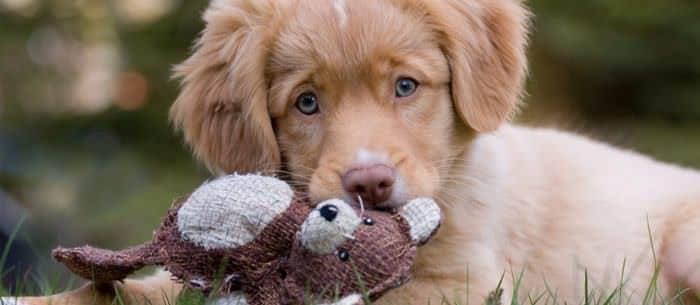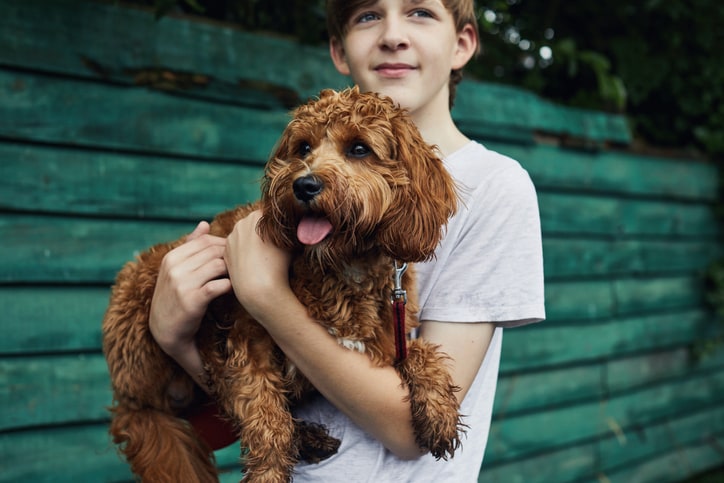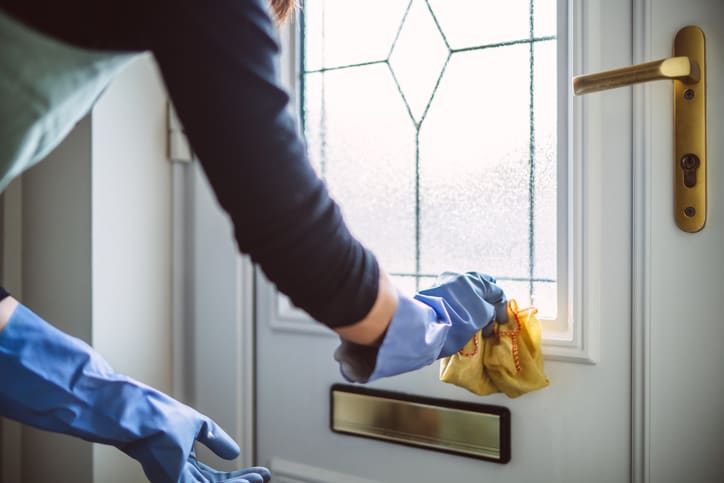There are few things more magical than watching a puppy grow.
If you’re really in on all the action from day 1, you’ll watch in awe as they open their eyes, carefully (and sometimes not so carefully) explore the environment around them with their nose and gradually grow into those oversized paws.
To help you know what to expect during the most adorable weeks of a puppy’s life, we asked an expert veterinarian to share key happenings and care information through the early stages, from day 1 to 48 weeks.
Stage 1: newborn to 3 weeks old—silent senses
You may think interacting with a puppy early on only serves you—by optimising the cuteness on all your social media channels—but, according to the expert, there are benefits for the puppy, too. During the first 3 weeks of life, a puppy is almost devoid of senses. Its eyes, ears and nose won’t work properly until week 3, and they won’t respond to stimuli from humans until then, either. Puppies sleep most of the time, which is vital for their development. Nevertheless, tactile stimulation can still foster the puppy’s development.
Tactile stimulation is something that puppies need, but there should always be respect for the puppies’ mother. There are actually studies that show that a few minutes of stimulation and handling newborn puppies favours their development, and makes the puppy more resistant to stress. This may be due to the puppies being touched, or it may be that touching puppies stimulates the mother’s licking of them. Whatever it boils down to, handling puppies is important for their development.
Training during this period
You won’t actually be training this adorable ball of fluff for many, many weeks, but there are ways you can set puppies up for success, specifically by exposing them to background sounds that are typical of their environment.
Puppies should gradually be exposed to the stimuli that will be part of their life. For example, let’s say a dog is born in a very quiet environment, like the countryside or the suburbs, and then later moves to the city : it may have problems adapting to the new environment.
The expert recommends playing smart with your puppy during this time. If you play with your hands and the puppy goes bananas, you know that at some point the puppy is going to bite you. The little teeth of a puppy are really sharp, so this can be quite painful! If this happens, punishing them might cause anxiety and stress for the puppy. So, the best way to set the puppy up for success is to play with something other than your hand if you know they are going to bite you.
Stage 2: 3 to 8 weeks old—socialising with siblings
If the first 3 weeks of life were the sleepyhead phase, this is the phase of awakenings! By the 4th week, the pup should be able to walk. There are important goings-on between mother, puppy and siblings—strengthening the case for puppies staying with their mothers as long as possible in their early stages of life. Mum begins weaning the pups and starts teaching discipline. The pup will socialise with its siblings, and the puppies will be biting each other and learning bite inhibition through this play-biting—skills that will come in handy later as they age.
The senses—sight, smell and hearing—all start to mature, so the dog can reach for stimuli from the environment. This is when the socialisation starts. Their fear threshold is still very high; like children, they are not afraid of anything. They see something and immediately want to throw themselves at it, whether it’s a big dog or another animal. Mother Nature keeps the fear threshold high so that the puppy can be exposed to the stimuli that would be part of the normal environment. Still, maternal care is the key component here.
Don’t forget to start their jabs during this time. Consult with your vet to determine the right puppy vaccinations schedule for your pooch.
Training during this period
To help the puppy grow into a well-adjusted dog, it’s important to start to expose them to stimulation, under the careful supervision of mum.
What you should do is hold the puppy, handle it briefly, and start to have it get used to being touched and to our smells. At around 8 weeks, they start to become more playful, so it’s possible to engage in gentle play with them.
Careful interaction is key here. You should aim to keep the handling and interaction below the fear threshold. If we do something that the puppy thinks is scary, this is not a good way to socialise a young dog. Rather, expose them gradually to an environment that they have to get used to, but always keep them below the fear threshold. This is crucial in the 3rd stage, because after 8 weeks is when the threshold for fear starts to decrease and puppies start to become more and more wary.
It’s worth noting that socialising with other dogs will usually start within the same litter, and once a puppy leaves its siblings—usually occurring between this stage and the next—socialisation with other puppies can begin.
However, this should be done in a safe environment where all the puppies are in good health. Dog parks should be avoided, but reputable puppy socialisation classes in a clean environment can be a great opportunity for socialisation.
Stage 3: 8 to 12 weeks old—fear of the new
That adorable ball of fluff is becoming more independent and starting to really get the hang of physical coordination by now. They will continue to learn about everything around them, like what’s safe and what’s unsafe.
The puppy soaks up everything like a sponge, according to the expert, who recommends that the puppy’s adoption take place between stage 2 and this stage, at around 8 weeks old.
At 8 to 12 weeks old, the fear response starts to become more pronounced. So, if you wait too long, it’s going to be more difficult to acclimate the puppy to the new environment.
The owner or care provider should try to make the puppy’s experiences during this period as positive and comforting as possible, because they can be hypersensitive to upsetting incidents.
Training during this period
From about 7 to 8 weeks of age, owners can start promoting some independence in their puppies.
At the beginning, this can be as simple as giving the dog a treat or toy to chew on while on a mat away from the owner, but in the same room. This time of independence can then progressively be increased, but it’s important to keep in mind that puppies need plenty of social interaction and should not be left alone for hours on end.
If a dog owner plans to get a puppy and then go to work for 8 to 10 hours a day, then they should really reconsider whether getting a dog is a good idea.
House training your puppy can begin at 8 weeks old, and other training by 9 weeks old. Negative experiences can have an impact on the pup, so take care, just like their mother would.
Many people think that having guests come in and handle the puppy helps it to become comfortable around people, but this is not the case. If someone handles the puppy and it gets scared, for example because they pick it up too quickly and it loses contact with the floor, or because a young child has accidentally hurt it, these negative experiences can leave a profound impression. This is very, very important to be aware of in stage 3.
Something else to be aware of: Don’t encourage forms of play that are inappropriate. The puppy has to learn that there is a way of playing with humans that does not involve biting their hands. So, instead of playing rough with a puppy with your hands, use toys.
Stage 4: 12 to 24 weeks old—chewing everything in sight
With the puppy’s first permanent teeth making their appearance now, chew toys are a must-have.
Chewing is an exploratory behaviour, so puppies naturally chew a lot. They start to become extremely proactive in this stage. Now is when they are more likely to leave their mother’s side and just go around and explore.
The expert recommends an exercise pen or limited area where you can supervise what the puppy is getting up to. Be sure to provide them with enough stimulation, enough toys, human contact and interaction. Fill toys with some food to stimulate this chewing behaviour.
This is also when you can enrol your puppy in its first training class, like a puppy socialisation class. It’s a good time to have exposure to people again in a controlled way, where you can observe your puppy a lot, start to pick up their body language and understand when they’re feeling uncomfortable in a situation.
Training during this period
This is the age to start practising some easy training.
The expert says you can start to work, for example, on calling the puppy with a happy voice. Puppies and dogs, in general, are much more likely to listen to us if we use a happy tone of voice, and there are studies that back this up. They want to go for positive stimuli where they expect the outcome is going to be good. Work on gentle recalling and then giving the puppy a treat.
This is also a very important time for house-training, especially for toilet training a puppy. Take them out when you anticipate that they are going to do their business, usually every 2 to 3 hours, but definitely after meals, when they’re excited or when they wake up.
You can also start a puppy crate-training schedule during this stage, which can help with toilet training and separation anxiety.
If they pee or poop in the crate, just clean it up; getting upset about it doesn’t fix anything. This is the time puppies should get used to staying in the crate.
It’s a good idea to make the crate a fun place in the beginning to enforce the positive rather than the negative.
The dog should not be locked in the crate and left alone, because they will not associate the crate with a fun place if you do that. Instead, it will be more like a prison to them. You should put in interesting toys and water—never deprive dogs of water, especially puppies. The crate should be a nice environment, not a timeout.
Stage 5: 24 to 48 weeks old—teenage doghood
At this age, your pup is old enough to have regular walks outside, and the toilet training may be complete. The more the dog matures, the more the training can be intensified, because their attention span will have increased.
Exploratory behaviour is important right now and a part of the learning process. Allow the dog to sniff the environment when you take it out for walks. It’s OK for your dog to explore the environment and start to recognise the smells, because dogs communicate through scent. By letting them sniff, they will learn how many dogs there are in the area. Allowing your dog to explore the environment at this age is very important.
Typically, spaying or neutering of your puppy is done at 6 months old. Talk with your vet about timing.
Training during this period
At this point, you can move on to more advanced training. Perhaps try to start exposing the dog to more professional training, for example, if you want them to be a working dog or an agility dog.
It’s also important to help your puppy acclimate to receiving regular veterinary care. When the dog goes to the vet for its first vaccines, it should be exposed to positive things. Some vets use baby food a lot with their patients. While they are focused on eating the food, the veterinarian administers the vaccines. This type of gradual exposure should continue throughout the other stages, too.
Also try getting the dog used to the waiting room by doing what the expert calls “happy visits”. Here, you sit in the waiting room, give the dog some treats, and then go home again. You need to get the dog used to the vet at this stage, when it’s still easy to handle. Otherwise, when it gets big, vet visits might cause trouble.


